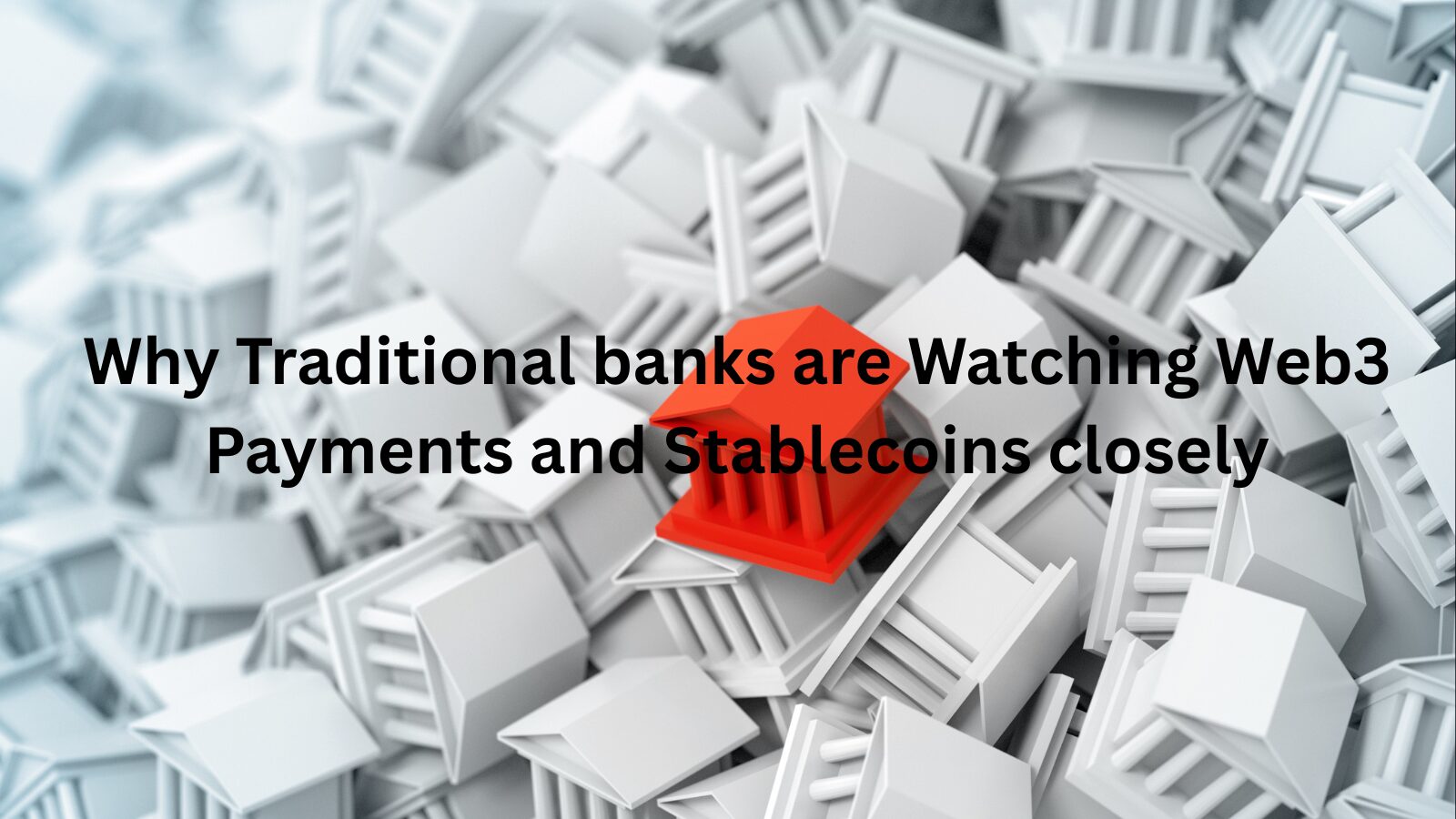The financial sector is at a crossroads. Traditional banks, which have been symbols of global commerce for years, are repeatedly facing changes in payment systems caused by Web3. These banks are watching the Web3 payment system and its technology with curiosity and concern. Why?
Web3 payment solutions, unlike traditional ledger structures, use a blockchain-powered technology, offering a much faster, transparent, and cost-saving system that many banks might struggle with.
Imagine sending money across borders in a matter of seconds and not days, paying near-zero fees, without intermediaries involved. This is the promise of web3 payments, where DeFi protocols, stablecoins, and smart contracts are replacing outdated banking infrastructure. However, this trend is not theoretical. Major banks like JPMorgan, HSBC, and BNY Mellon are already experimenting and implementing blockchain solutions into their banking infrastructure to improve payment. Governments are pushing CBDCs (central bank digital currencies) to achieve the same result.
In this article, we will look at why banks are adopting web3 payment systems, real-world applications, use cases of web3 payment solutions in banks, and future predictions.
Key Web3 payment Growth: Banks are monitoring.
The rapid growth of Web3 payment is forcing traditional banks to rethink their payment practices and join the global finance trend. Here are some critical developments that are shaping the web3 payment:
- Explosive Growth of Stablecoins
With the average number of stablecoins in circulation rising by about 28% annually, the use of stablecoins has grown in recent years. The aggregate volume of Visa and Mastercard transactions in 2024 was surpassed by the $27.6 trillion total transfer volume last year.
The biggest stablecoin at the moment is Tether (USDT). 2014 saw the release of USDT, which is based on the US dollar and accessible on some significant blockchains, including Ethereum, Solana, and Tron. With a market valuation of more than $143 billion, stablecoin is the industry leader. However, there are issues with USDT because of false claims made about the underlying assets of the stablecoin.
- Increased DeFi Adoption
Decentralized Finance (DeFi) has moved from niche experimentation to wider adoption by companies. For instance, Balckrock’s BUIDL has surpassed $1.7 billion after the Solana expansion.
According to RWA.xyz, BUIDL is the market leader in the tokenised U.S. Treasury sector, with a 34% market share and a $1.7 billion market capitalisation. Hashnote, Franklin Templeton, and Ondo USDY come next. With a $500 million market capitalisation in July 2024, BUIDL has had a 240% growth in just seven months. With a market valuation of $3.6 billion, or 72% of the market, Ethereum-based treasuries continue to rule the industry.
- Central Bank Digital Currencies (CBDCs)
The CBDC adds another layer of growth and complexity to this transformation. Currently, over 130 countries are developing their central bank digital currency, led by China’s digital yuan, which has already achieved $250 billion in transaction volume.
Will banks adopt e-finance fast|Source: Chinadaily.
Right now, traditional banks find themselves preparing for the future and looking for ways to incorporate national currencies with digital currency.
- Smart Contract- Settlements
At the same time, back-office activities are being revolutionized by smart contract technology. Assets that used to take weeks to settle can now be exchanged in a matter of seconds thanks to HSBC’s tokenised gold platform.
Similar changes are taking place in the insurance, derivatives, and trade finance sectors, where programmable contracts are doing away with conventional processes and cutting payment times from days to seconds.
Why Banks Can’t Ignore Web3 Payments
Let’s be honest- banks aren’t as fast as we hoped they would be. But when it comes to Web3 payment, things are much faster, which is gaining traditional banking customers’ attention. Here are some reasons banks are now paying attention to Web3:
- Customers are demanding better.
Banks, individuals, businesses, and customers are tied to slow transactions and hefty transaction fees. These pain points are what web3 seeks to solve. With blockchain-based payments, money moves across borders in minutes with no hefty costs and no middleman in the transaction process.
So as not to lose customers, banks are considering other solutions such as crypto payments, crypto wallets, DeFi apps, and other alternatives.
- Increased bank onboarding:
While some banks are still debating when and how to onboard to Web3, their competitors and new fintech companies are already pushing this trend. For instance, PayPal now lets users send and receive crypto. Similarly, Avalanche launched a crypto card to help users buy anything and pay for goods and services supporting crypto assets like USDC, USDT, AVAX, and wrapped AVAX (wAVAX).
- Cost savings are too big to ignore.
Banks spend billions on resolving fraud complaints, dealing with intermediaries, and maintaining outdated payment systems. Web3 significantly reduces such expenses. Stablecoins lower cross-border fees, blockchains lower fraud, and smart contracts automate procedures.
For banks, this is about survival, not simply about innovation. Reduced expenses translate into higher profits and more satisfied clients.
Future Predictions
By 2030, Web3 won’t just disrupt banking—it will redefine it. Expect hybrid models where traditional banks merge with decentralized finance, offering blockchain-powered accounts that work seamlessly with crypto wallets. Central bank digital currencies (CBDCs) will replace cash, while smart contracts automate loans, compliance, and settlements in real time.
Cross-border payments will shift entirely to blockchain networks like Ripple and Stellar, making SWIFT obsolete. Tokenized assets—from real estate to stocks—will become mainstream, traded 24/7 on decentralized markets. Banks that resist will fade into “legacy” status, serving only niche clients.
Regulation will catch up with clear rules for DeFi, stablecoins, and DAOs. The biggest winners? Banks that act now—building Web3 infrastructure, acquiring crypto-native talent, and partnering with fintechs. The future isn’t just digital—it’s decentralized.
Risk and Challenges
- Regulatory Uncertainty – Governments are still figuring out how to regulate DeFi, stablecoins, and crypto. Banks could face compliance whiplash as rules evolve.
- Security Threats – Smart contract bugs, hacks, and private key mismanagement could lead to catastrophic losses. For instance, over $2B was stolen in DeFi hacks in 2023.
- Tech Integration Challenges – Legacy banking systems weren’t built for blockchain. Retrofitting them is costly and complex.
- Loss of Control – Decentralization means banks no longer fully “own” payment rails—a scary thought for institutions used to being gatekeepers.
- Public Skepticism – Many still distrust crypto after scams and crashes. Banks must rebuild confidence while innovating.
Conclusion
Web3 isn’t a passing trend—it’s the future of finance. Banks that embrace it will unlock faster transactions, lower costs, and new revenue streams. Those that resist will lose customers to agile fintechs and crypto-native platforms.
The path forward? Strategic adoption. Partner with regulators, invest in blockchain talent, and gradually integrate Web3 solutions while managing risks. The winners won’t be the biggest banks—but the smartest movers.
The question isn’t if Web3 will reshape banking—it’s which banks will lead the change.






